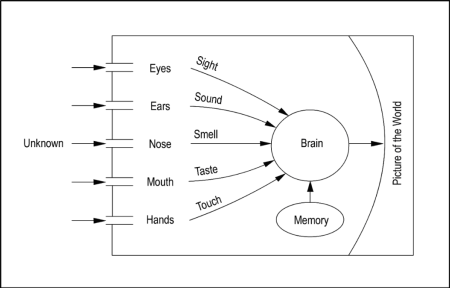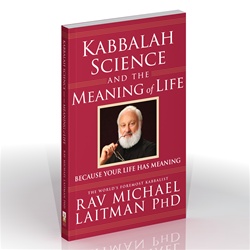A Crash Course in How You Perceive Reality
We might compare a human being to a closed box with sensors: eyes, ears, nose, mouth, and hands, representing the five senses: sight, sound, smell, taste, and touch.
As we have previously said, the fundamental principle in perceiving reality is that of “equivalence of Form,” which means equilibrium of pressures. The senses function as sensors, each with a different reaction to the pressure, depending on the make up of the sensor. The sight sensor evokes a reaction of light, darkness, and colors; the sound sensor evokes sounds; the smell sensor evokes scents; the taste, flavors; and the touch, sensations such as hard, soft, warm, and cold.
The reaction of the senses is transferred to the brain’s control center, where the information is compared with the data that already exists in the memory, the reservoir of prior impressions. In this manner, we process what our senses gather, determine the most advantageous reaction, and study where we are and how best to function in our environment. When the process is completed, the information is “projected” unto a “screen” within the brain, portraying what is ostensibly in front of us (see diagram).

Why What You Perceive Outside of You Is Really Inside of You
In this process, the surrounding unknown becomes “known,” and a picture of the external reality is created. However, the picture is not one of external reality, but merely an internal picture, a result of the structure of human senses and preexisting data. If we had different senses, we would produce an entirely different picture. Quite possibly, if we perceived through different senses, what appears as light would appear as dark, or even as something so fundamentally different that we cannot imagine how it would appear to us.
Science has known these facts for some time now. Today, we can replace senses using manmade means such as electronic devices. Although science has yet to fully master these techniques, in time it will be able to expand the reach of our senses, create new organs, and even produce a complete new body. Nevertheless, even with a new body, the pictures will remain within. Science has long since proven that the sensations of being in certain places and situations can be evoked through electric stimuli to the brain in conjunction with data stored in the memory.
All of the above teaches us that everything we feel comes from within, irrespective of our surrounding reality. We cannot even be certain that there is an outside reality. Because the picture of the “outside” world lies within us, Kabbalists refer to the world we see as “the imaginary world.”
Discover the One Desire that Expands Your Perception of Reality
Everything is made of a desire to enjoy. In humans, this general desire to perpetually enjoy evokes desires to take pleasure in particular things, which change at any given moment. Combined with the information stored in the memory, this desire operates our senses toward what is momentarily desired. The evolution of the desire for pleasure throughout the generations eventually leads to a desire for something unknown called “the point in the heart.” Today, this desire is awakening in many of us.
The problem with this desire is that there is no corresponding data that relates to it in our memory. Even the senses cannot locate a source of satisfaction for this new craving. When that desire arises in us, we stand helpless because there is nothing in the world around us that can satisfy it. But when this desire arises, it makes our lives prior to its appearance seem repellent.
The point in the heart is the beginning of an entirely new sensory system, completely detached from the present, natural system. When this new system is fully developed, it will be called “a soul.” The soul will contain a new brain, a new memory, and a new “screen.” Using it, one sees a whole new world-picture, that of the spiritual world. Thus, there are two separate sensory systems that operate similarly: the natural, corporeal system, and the spiritual system.
Are You in the Right Environment to Reveal the Spiritual Reality?
In the natural system, the world-picture appears at the moment of birth. We needn’t do anything to create it, which is a substantial difference from the spiritual system. We experience many things through life, experiences that enrich and develop our memory, enhance our ability to process greater and greater subtleties, and make numerous interconnections and connotations. As a result, the picture created in our mind grows more and more lucid. This is the difference between the infant’s perception of the world and the mature perception.
For the point in the heart to evolve into a system of spiritual perception, one must acquire a great desire for it. Since the spiritual world is hidden, the only way to intensify the desire for it is through the right environment. When one wants to progress spiritually, one is led to an appropriate environment, according to the measure of the will to receive. This is a natural process that happens as a result of the law of equivalence of Form, by which one is situated in the spiritual system according to one’s desire to partake of it.
This environment comprises three elements: a Kabbalist guide, Kabbalistic texts, and a society of people with a similar desire. From this point on, one’s evolution depends on one’s desire to utilize this environment correctly, i.e. to enhance the desire for spirituality. When, and only when, the desire for spirituality grows to the required intensity to create another sensory system, the picture of the spiritual world will be created in that person.
This is the only purpose for which Kabbalistic texts were written. By correctly studying these texts, the construction of the soul is facilitated. Baal HaSulam (Kabbalist Rabbi Yehuda Ashlag) describes this in the following manner:
Therefore we must ask, why then, did the Kabbalists obligate each person to study the wisdom of Kabbalah? Indeed there is a great thing in it, worthy of being publicized: There is a wonderful, invaluable remedy to those who engage in the wisdom of Kabbalah. Although they do not understand what they are learning, through the yearning and the great desire to understand what they are learning, they awaken upon themselves the Lights that surround their souls.
…when one engages in this wisdom, mentioning the names of the Lights and the vessels related to one’s soul, they immediately shine upon us to a certain measure. However, they shine for him without clothing the interior of his soul for lack of the able vessels to receive them. Despite that, the illumination one receives time after time during the engagement draws upon one grace from above, imparting one with abundance of sanctity and purity, which bring one much closer to reaching perfection.
–Baal HaSulam, “Introduction to the Study of Ten Sefirot,” item 155
Why Entering the Spiritual Reality Gives One the Ability to Live Forever
Once the first picture of the new reality appears, the remainder of the evolution unfolds in a process the Kabbalists call “one’s soul teaches one.” The picture of the corporeal world becomes clearer as one matures and accumulates impressions. Here, too, one accumulates sensations and impressions of the spiritual world that enrich the new memory and analytic abilities of the new mind. Consequently, the world-picture created within the new sensory system becomes increasingly clearer.
The death of the biological body means that the natural system has ceased to function. The senses no longer transfer information to the brain, and the brain stops projecting the picture of the corporeal world on the “screen” within it. Since neither desires nor fulfillments in the point in the heart—from which the spiritual system evolved—belong to this world, this point continues to exist after the departure of the body.
If one has come to perceive one’s existence in the spiritual system and has come to identify oneself with it before the demise of one’s body, that person will continue to sense his or her spiritual existence past the death of the body. This is the meaning of existence in the soul.
Do You Recognize the Real Reason Why You Experience Constant Changes in Your Life?
According to Kabbalists Baal HaSulam and the Holy Ari, to name just two, all that exists outside of us is the Light that fills the entire reality, and which is in complete rest. Although we are within that Light, we feel as if we exist inside a body situated within a surrounding universe.
Yet, as previously stated, impressions fill us through the five senses. Thus, if all that exists around us is the unchanging Light, what is it that makes us perceive constant changes?
To answer that question, we must return to the Reshimot (reminiscences). As we have said earlier, within the will to receive there is a chain of Reshimot, a chain that continuously evokes new Reshimot. The internal world-picture we experience is actually a manifestation of the difference, the contradiction between the presently active Reshimo (singular for Reshimot) and the Light.
The Light outside us does not change; only the Reshimot within us change. Our perception of ourselves and the world around us results from projecting the internally unfolding changes in our desire upon the constant, resting Light. The renewal of the Reshimot and the way one realizes them create our changing pictures of the world.
 “Do You Make These Common Mistakes When Perceiving Reality?” is based on the book, Kabbalah, Science and the Meaning of Life by Dr. Michael Laitman.
“Do You Make These Common Mistakes When Perceiving Reality?” is based on the book, Kabbalah, Science and the Meaning of Life by Dr. Michael Laitman.

